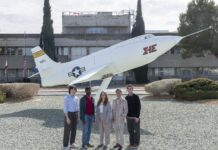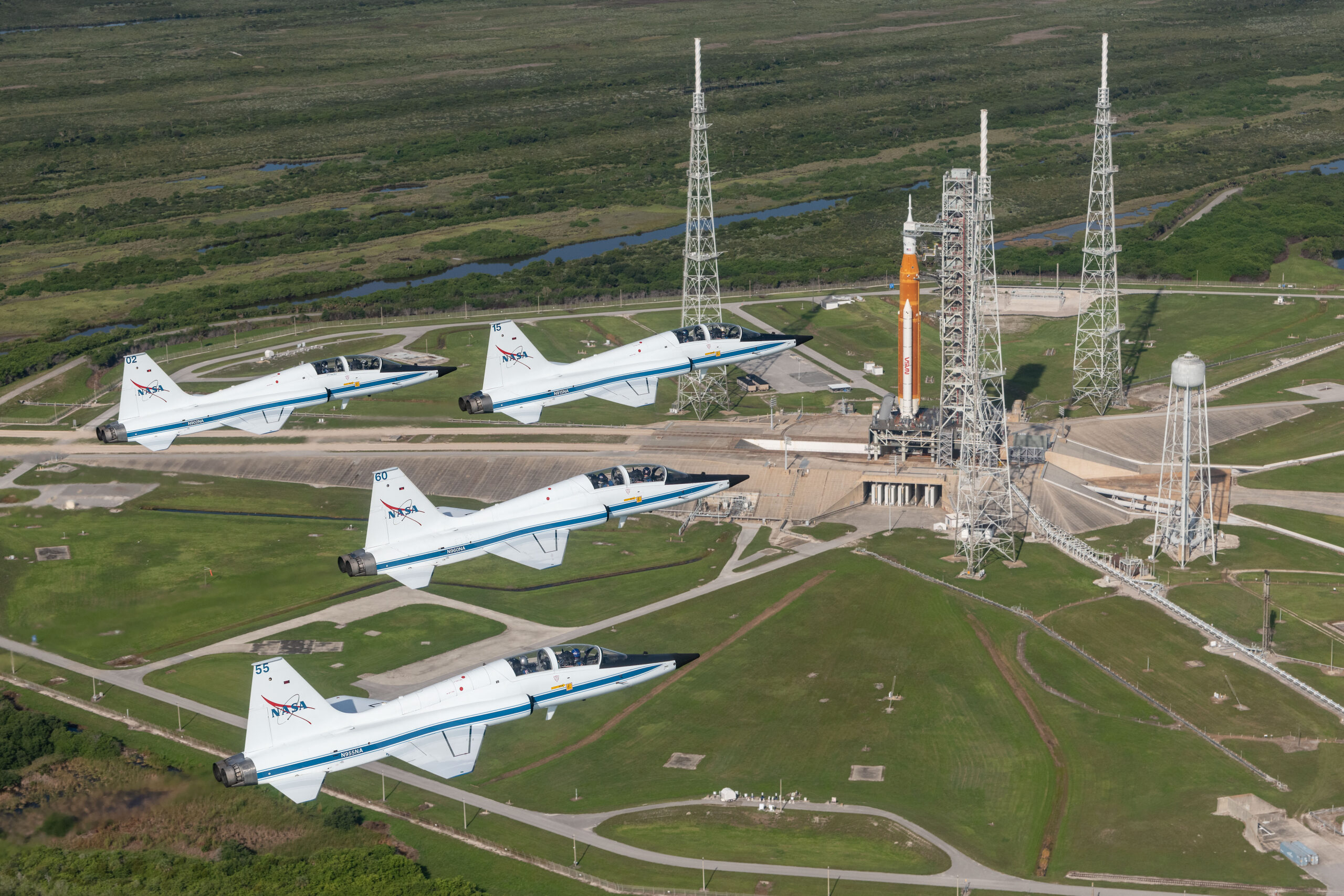—
NASA’s T-38 Jets Fly in Formation Above Space Launch System Rocket at Kennedy Space Center
NASA recently showcased an impressive aerial display as a fleet of T-38 jets flew in precise formation over the Space Launch System (SLS) rocket, which was stationed on Launch Pad 39B at Kennedy Space Center, Florida. This event not only demonstrated the coordination and skill of NASA pilots but also highlighted the ongoing preparation and excitement surrounding the Space Launch System, a key component of NASA’s future deep space missions.
Details of the Aircraft and Crew
The formation involved five T-38 jets, each carrying notable astronauts and astronaut candidates. These jets, which are primarily used for astronaut training, flew in a carefully orchestrated pattern above the towering SLS rocket. Below is a breakdown of the aircraft designations and the distinguished individuals on board:
- Jet 901: Piloted by Chris Condon, accompanied by astronaut Zena Cardman.
- Jet 902: Flown by astronaut candidate Nicole Ayers, with astronaut Christina Koch as co-pilot.
- Jet 903: Commanded by Canadian Space Agency astronaut Jeremy Hansen, with astronaut Drew Morgan.
- Jet 904: Chief astronaut Reid Wiseman piloting, with astronaut Joe Acaba as co-pilot.
- Jet 905 (Photo Chase): This jet was responsible for capturing the event, piloted by astronaut candidate Jack Hathaway, with photographer Josh Valcarcel.
The Space Launch System (SLS) Rocket
The SLS rocket is a cornerstone of NASA’s Artemis program, which aims to return humans to the Moon and eventually conduct crewed missions to Mars. The rocket’s powerful design allows it to carry astronauts, scientific equipment, and cargo beyond Earth’s orbit. The recent formation flight over the SLS signifies the ongoing preparation and commitment to these ambitious space exploration goals.
What is the Space Launch System (SLS)?
The SLS is NASA’s next-generation heavy-lift rocket, designed to be the most powerful rocket ever built. It will enable missions beyond low Earth orbit (LEO), which is the region of space within about 1,200 miles of our planet. Unlike the rockets used for missions to the International Space Station, the SLS will have the capability to propel astronauts and cargo to the Moon, Mars, and beyond.
Kennedy Space Center’s Role in Space Exploration
Kennedy Space Center has been the launch site for numerous historic missions, including the Apollo moon landings and space shuttle launches. The center continues to be a critical hub for NASA’s space exploration efforts. Launch Pad 39B, where the SLS is situated, has been upgraded to support the requirements of modern space missions, ensuring it can accommodate the immense power and size of the SLS rocket.
Interesting Fact: What is Launch Pad 39B?
Launch Pad 39B is one of NASA’s two launch complexes at Kennedy Space Center. It was originally built for the Apollo program and later modified for the Space Shuttle program. Now, it has been upgraded once again to support the Space Launch System, demonstrating its enduring importance in NASA’s launch capabilities.
The Role of T-38 Jets in NASA’s Operations
T-38 Talon jets have been a staple in NASA’s fleet since the 1960s. These aircraft are used primarily for astronaut training, offering a high-speed, high-performance platform that helps astronauts develop the skills needed for spaceflight. The T-38s provide an environment where astronauts can practice navigation, formation flying, and other critical skills. Moreover, they are used for proficiency flights to ensure that astronauts maintain their flying skills.
Why Are T-38 Jets Important?
The T-38 jets play a crucial role in astronaut training because they simulate certain conditions of spaceflight, such as high speeds and rapid decision-making scenarios. This training is essential for preparing astronauts for the rigorous demands of space missions.
Reactions and Reviews
The aerial display was met with enthusiasm and admiration from both the public and the space community. Social media buzzed with awe-inspiring images and videos of the T-38 jets flying above the SLS rocket, capturing the imagination of space enthusiasts around the world. The event also served as a powerful reminder of the teamwork and precision required in space exploration.
Public Reaction:
"Seeing those T-38 jets flying over the SLS rocket was a breathtaking sight! It really brings home the scale and excitement of NASA’s upcoming missions." – A space enthusiast on Twitter.
Conclusion
The recent formation flight of NASA’s T-38 jets over the Space Launch System rocket at Kennedy Space Center is more than just a visually stunning event. It symbolizes the meticulous preparation, teamwork, and technological prowess that underpin NASA’s ambitious plans for deep space exploration. As the SLS rocket continues to undergo rigorous testing and preparation, such events provide a glimpse into the future of human spaceflight, sparking excitement and anticipation for the next giant leap in space exploration.
Good to Know:
- Astronaut Training: The T-38 jets are integral to astronaut training, offering a platform for astronauts to practice and hone their flying skills.
- SLS Rocket: The Space Launch System is set to be the most powerful rocket ever built, designed to take humans deeper into space than ever before.
- Kennedy Space Center: A historic site that has been the launch point for some of humanity’s most significant space missions, now upgraded to support the SLS.
As we look forward to the Artemis missions and beyond, events like these remind us of the incredible journey ahead and the dedication of the men and women who make space exploration possible. The sky, quite literally, is not the limit.
For more Information, Refer to this article.


































